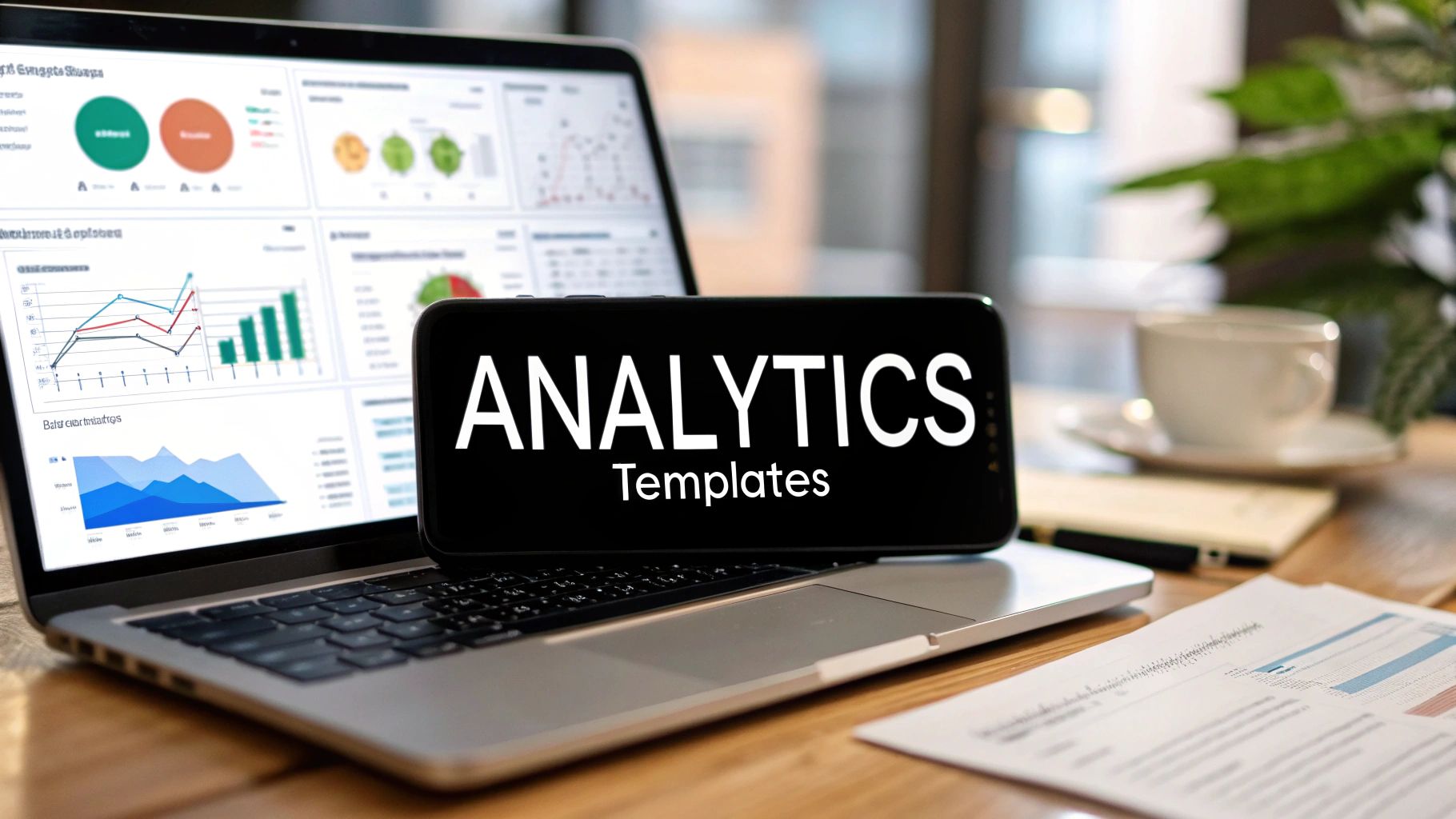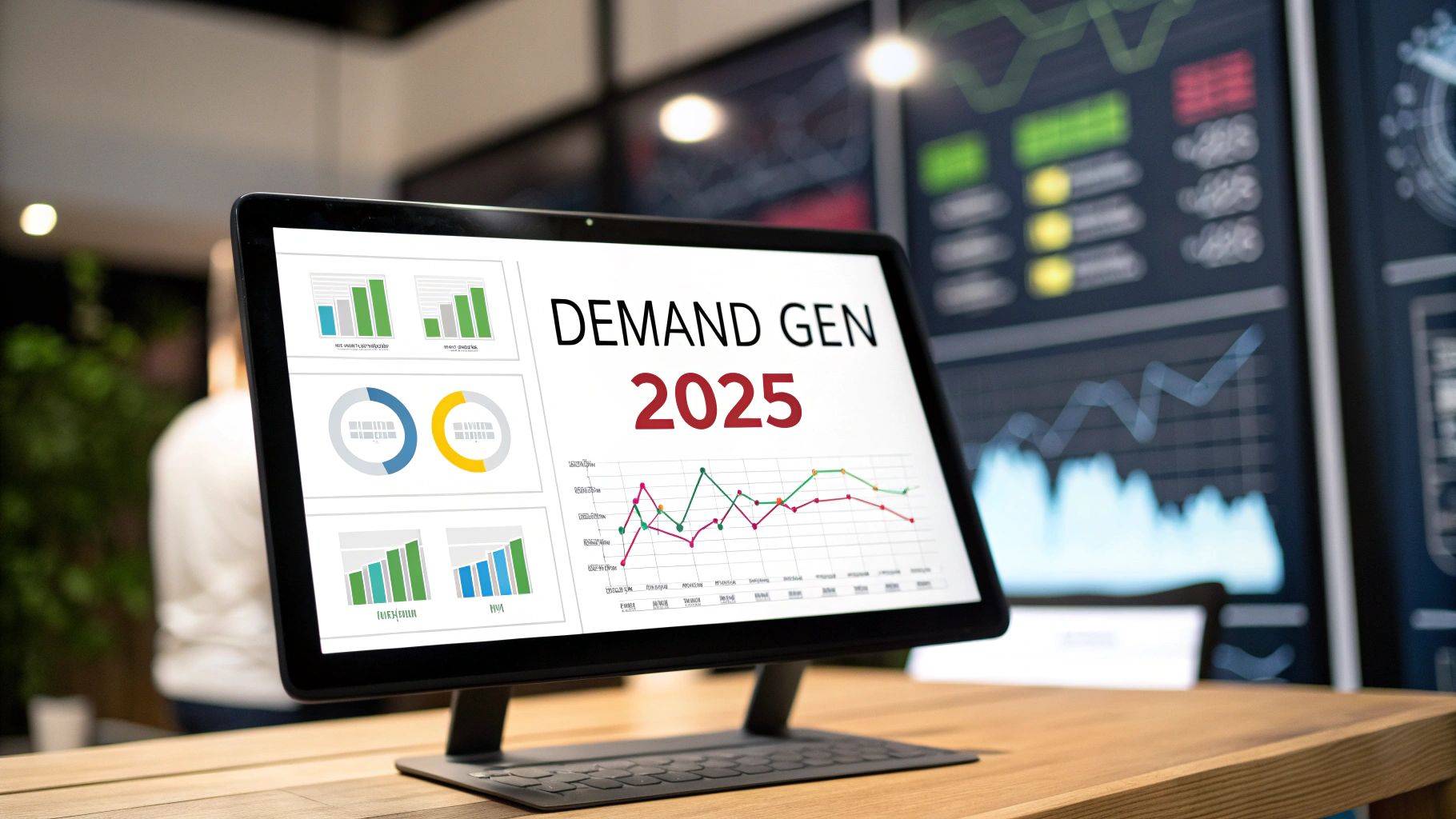Mastering Goals in Google Analytics for Better ROAS
- Chase McGowan
- 1 day ago
- 14 min read
You're pouring thousands into Google Ads, but can you prove it's actually growing your business? Setting up the right goals in Google Analytics is the first, most critical step to making every ad dollar accountable. This isn't just about tracking clicks; it's about measuring profit.
Why Your Agency Gets Google Analytics Goals Wrong

Let's be direct. The core problem with most large, bloated agencies is their one-size-fits-all approach to analytics. They hand your account to a junior manager who follows a standard playbook, setting up generic goals that look good on a report but do absolutely nothing for your bottom line.
This cookie-cutter method is how you end up with a portfolio of vanity metrics. You’ll see impressive numbers for clicks and sessions, but those metrics don't pay the bills. The reports get bloated with data that hides the one thing that actually matters: Return on Ad Spend (ROAS).
The Specialist Consultant Advantage
As a dedicated, individual Google Ads consultant, my approach is fundamentally different. I don’t use a generic template because your business isn't generic. I start by understanding your specific business objectives first, then I translate those into precise, high-value conversion actions inside Google Analytics.
My focus is on cutting out the fluff and only measuring what truly drives revenue. This is a level of individual specialization you simply won't get from an overpriced agency juggling dozens of clients.
Here’s what that difference looks like in the real world:
Agencies track: Vague metrics like "session duration" or "pages per visit." They're easy to set up and pad reports, but it's nearly impossible to connect them to an actual sale or qualified lead.
I track: High-intent actions like "quote_request_submitted," "demo_scheduled," or actual purchases with specific revenue values attached.
This hands-on, specialized approach transforms your Google Analytics from a passive reporting tool into an active profit-driver for your ad campaigns. It's a level of detail and strategic thinking that a bloated agency structure simply can't deliver.
Moving Beyond Surface-Level Tracking
Most agencies stop after the basic setup. They link your accounts, check a box, and move on to their next client, leaving you with incomplete and misleading data. A properly configured analytics setup should give you deep insights into the entire customer journey, not just the final click.
This is where a specialist shines. I don't just set up goals; I build a strategic framework that connects user actions directly to campaign performance. You get my direct expertise, not a junior employee's. We'll find out exactly which ads, keywords, and landing pages are producing paying customers, not just generating empty traffic.
Instead of getting a report packed with confusing numbers, you get a clear, actionable plan built on data that matters. This is the critical disconnect that costs businesses thousands in wasted ad spend—and it’s the exact gap I close for my clients.
From Universal Analytics Goals to GA4 Conversions
The move from Universal Analytics (UA) to Google Analytics 4 (GA4) wasn't just a facelift—it completely tore up the old rulebook on how we measure online success. Getting a handle on this evolution is your first step to building a truly effective tracking strategy, and it’s where a lazy agency’s cookie-cutter approach starts to fall apart.
Think of UA Goals like static finish lines. They were great at telling you if someone crossed a specific line, like hitting a "thank you" page. But they offered almost no insight into the journey they took to get there. It was a rigid, session-based model that gave you a snapshot, not the full story.
GA4, however, runs on a totally different engine. It’s an event-based model that’s more like a GPS tracker following every user's entire journey. Instead of just a few finish lines, GA4 logs every meaningful interaction—a video play, a deep scroll, a file download—as an event. You then get to decide which of these high-value events to flag as Conversions, giving you a much richer narrative of how your customers actually behave.
Why This Shift Matters for Your Ad Spend
This leap from a session-focused view to an event-driven one is a massive game-changer for anyone running paid ads. It’s the difference between knowing a lead came from an ad, and knowing the exact sequence of clicks and interactions that led to that conversion. That kind of granular detail is an absolute goldmine for optimization.
This is exactly where my hands-on consulting approach proves its worth over a typical agency. Most agencies just apply the old UA mindset to GA4, lazily marking a 'page_view' on a confirmation page as a conversion and calling it a day. That kind of setup completely ignores the wealth of intelligence GA4 is built to provide.
As your consultant, I go deeper. I use GA4's event-based model to map out the entire user path, identifying crucial micro-conversions that signal real intent. This leads to smarter ad spend and optimizations that a bloated agency, focused on hitting vanity metrics, will almost always miss.
By 2025, the business world has clearly caught on. GA4 is now the standard, with 14.2 million websites actively using the platform worldwide. Among the top 10,000 websites, over 43% have already made the switch, showing a clear trend toward this more powerful technology. You can dig into more details on the widespread adoption of GA4 here.
The Core Differences at a Glance
Let's get straight to the point and break down what’s actually different. This isn't just about new names for old features; it’s a fundamental overhaul that directly impacts your ability to measure ROAS with any real accuracy.
Comparing UA Goals and GA4 Conversions
Feature | Universal Analytics (UA) Goals | Google Analytics 4 (GA4) Conversions |
|---|---|---|
Measurement Model | Session-based, focused on what happens in a single user visit. | Event-based, focused on every single user interaction across their entire journey. |
Tracking Flexibility | Rigid and limited to 4 goal types (Destination, Duration, Pages/Session, Smart Goals). | Extremely flexible. Any event you track can be marked as a conversion. |
Goal Limits | Capped at 20 goals per view. Often not enough for complex businesses. | Up to 30 conversions per property, plus several default, auto-collected conversions. |
Retroactive Data | Goals only tracked data from the moment they were created. No looking back. | Conversions apply from the moment they're flagged, but the underlying event data is already there. |
Moving to GA4 conversions isn’t just about keeping up with Google. It’s about equipping your business with better data to make much smarter decisions. For a PPC campaign, this means finally understanding which specific user actions truly drive revenue, letting you optimize your ad spend with a level of precision that was just a pipe dream with old UA goals. It’s a shift from basic tracking to genuine business intelligence.
How to Set Up GA4 Conversions That Drive Profit
This is where the real work begins—moving past theory and creating tangible value for your business. Setting up goals in Google Analytics, now called conversions in GA4, isn't just a technical box-ticking exercise. It's a strategic process. A bloated agency might just flip a switch on a default event, but an expert builds a tracking framework that directly mirrors your path to profitability.
It all starts with one simple question: what actions on your website actually make you money? It's almost never "viewing a page." It's submitting a quote request, scheduling a demo, or completing a purchase. These are the high-value interactions we need to isolate and measure with total precision.
Creating High-Value Events in Google Tag Manager
First things first, we need to create custom events to capture these crucial actions. Google Tag Manager (GTM) is the perfect tool for this. Instead of generic events, we're building specific, profit-focused ones.
For instance, instead of tracking all form submissions under a generic event, we get granular. We create distinct events that tell a real story:
: This fires only when the "Request a Quote" form is successfully sent.
: This is triggered the moment a user books a product demo through your scheduling tool.
: This captures a new lead dropping into your marketing funnel.
This level of detail is what separates actionable data from noisy, useless reports. It’s a hands-on approach that big, overloaded agencies often skip because it takes more time and focus than their cookie-cutter model allows.
This infographic shows the strategic shift from basic UA Goals to profit-driven GA4 Conversions.You can see how modern analytics is all about tracking the entire customer journey (the event) before singling out that final, most valuable action (the conversion).
Marking Events as Conversions in GA4
Once your custom events are flowing from GTM into GA4, the next step is dead simple but incredibly powerful. You have to tell GA4 which of these events actually matter enough to be called a conversion.
Just head into your GA4 property and navigate to . You'll see a list of every event being collected. All you do is find your high-value custom events (like ) and flick the switch to mark them as a conversion. It’s that easy.
The Overlooked Step: Assigning Monetary Value
This is it. This is the single most important step that countless agencies overlook, yet it's the absolute key to unlocking true ROAS measurement. For any conversion that isn't a direct e-commerce purchase, you must assign a monetary value. This is what turns your analytics from a simple bean counter into a powerful business intelligence tool.
Assigning a value to a non-purchase conversion connects your marketing efforts directly to potential revenue. This step changes the conversation from "how many leads did we get?" to "how much potential revenue did our ads generate?"
So, how do you calculate this? It's a straightforward formula based on your own sales data:
Lead-to-Close Rate: What percentage of leads from a specific source (like website quote requests) actually become paying customers? Let's say it's 10%.
Average Customer Lifetime Value (LTV): What's the average total revenue a new customer brings in? Let's say it's $5,000.
Conversion Value Calculation: (Lead-to-Close Rate) x (Average LTV) = Conversion Value.
In our example, that's 10% x $5,000 = $500. This means every single time the conversion fires, we can tell Google Ads and GA4 that this action is worth $500 to the business.
This data is pure gold for optimizing your ad campaigns. When you're setting up GA4 conversions that drive profit, it's also critical to attribute phone calls back to your ads by using a solid PPC call tracking guide. This makes sure offline conversions are valued correctly, too.
By feeding Google's bidding algorithms this precise financial data, you're enabling them to find more users who look just like your high-value customers. You’re maximizing your return on every single ad dollar spent. This is the difference between just running ads and running a truly profitable advertising system.
Connecting GA4 to Google Ads for Smarter Bidding
Once you’ve got high-value conversions firing correctly in GA4, the real magic begins. It's time to create a powerful feedback loop with Google Ads. This isn't just about linking two accounts; it’s about turning your analytics insights into fuel for smarter, automated bidding decisions.
This is where a hands-on consultant’s precision gives you an edge that a bloated, process-driven agency just can't match.
Simply connecting the platforms is the bare minimum. The game-changer is importing your custom GA4 conversions directly into your Google Ads account. This gives the ad platform a much richer, more accurate dataset than relying on the standard Google Ads conversion pixel alone.
Why is this so much better? GA4 captures the entire customer journey across different touchpoints and devices. When you import these conversions, you're giving Google's bidding algorithms a complete portrait of what a valuable user really looks like—an insight a generic agency setup will miss.
Your Advantage Over an Overpriced Agency
A big agency will link your accounts, maybe import a generic conversion, and check a box on their to-do list. My approach is different. I build a verified, seamless data pipeline you can trust completely. I don't move on until we know for a fact the data is flowing perfectly. It's a level of detail a junior account manager won't bother with.
This integration is about more than just data; it's about feeding Google's Smart Bidding algorithms with superior fuel. High-quality conversion data from GA4 leads directly to more efficient ad spend and a crystal-clear picture of your true Return on Ad Spend (ROAS).
When Google Ads understands that a event is worth $500, its automated systems can get aggressive, actively seeking out users who show similar behaviors. This is how you stop wasting money on low-value clicks and start investing in customers with real potential. You can dive deeper into how this works in our guide on how to master Google Ads automated bidding strategies.
My Personal Data Flow Verification Checklist
Verifying the connection is non-negotiable. An agency might just assume it's working, but in PPC, assumptions are expensive. Here’s a look at the process I follow for every client to guarantee the data is solid:
Confirm Account Linking: First, I head to in GA4 to ensure the connection is active and configured correctly.
Enable Auto-Tagging: I always double-check that auto-tagging is enabled in your Google Ads account. Without this, GA4 can't properly attribute traffic and conversions back to your campaigns, ad groups, and keywords.
Import Conversions in Google Ads: This is the most critical step. I go into and click "New conversion action." From there, I select "Import," choose the GA4 property, and bring in your high-value events like .
Check the "Conversions" Column: After a few days, I meticulously review the "Conversions" column in Google Ads and cross-reference it with the data in GA4. The numbers should line up closely, allowing for minor attribution differences. If I see a major discrepancy, it’s a red flag that needs immediate investigation.
This detailed process ensures that the goals in Google Analytics you so carefully defined are actively making your Google Ads campaigns smarter and more profitable. It’s the difference between just having data and actually using it to drive growth.
Using Your Data to Set Smarter PPC Goals
Setting the right goals is the bedrock of any profitable ad strategy. Now that your most valuable conversions are feeding directly into Google Ads, we can get past the technical setup and start thinking strategically. This is the part that separates campaigns that print money from those that just burn it.
A classic mistake I see all the time—often pushed by overworked, cookie-cutter agencies—is setting vague, mushy goals. Things like "get more leads" or "increase website traffic" are completely useless. Why? Because they're not accountable. My job is to make sure every goal we set is razor-sharp and tied directly to your bottom line.
Adopting the SMART Framework for PPC
To bring some much-needed discipline to your campaigns, we'll apply the SMART framework to your Google Analytics 4 data. This isn't just some buzzword; it's a practical filter for creating goals that actually produce measurable results.
Here’s how we transform a fuzzy wish into a powerful, data-driven objective:
Specific: We don’t say "more leads." We say, "Increase conversions from US-based mobile users."
Measurable: We use GA4 to track the exact count of these conversions and the value we’ve assigned to them.
Achievable: Looking at our historical data, is a target like a 15% increase actually realistic with our current budget?
Relevant: Does getting more demos directly help us hit our main business objective of growing enterprise sales?
Time-bound: We give ourselves a hard deadline, like "by the end of Q3."
Put it all together, and a vague idea becomes a concrete mission: "Increase conversions by 15% in Q3 by reallocating 20% of the budget to top-performing mobile campaigns." Now that's a plan. Suddenly, every decision has a clear purpose.
Pinpointing Opportunities with GA4 Reports
This is where having a specialist dig into your data makes a world of difference compared to the generic reports a big agency will send you. I don't just look at what's working. I spend my time in GA4's Exploration reports to figure out why things aren't working—and where the biggest untapped opportunities are hiding.
Funnel exploration reports are my go-to for this. They let us map out the entire user journey. For instance, we might build a funnel for your mobile checkout and find a jaw-dropping 70% drop-off between the "Add to Cart" and "Begin Checkout" steps.
That’s not just a number; it's a giant red flag. An agency might miss this detail in a high-level summary, but to me, it’s an immediate, actionable insight telling us exactly where to focus our optimization efforts.
Likewise, path exploration reports show us the messy, winding roads people actually take on your site. We might discover that users who read a specific case study before filling out a form convert at a 3x higher rate. That insight is pure gold. It tells us we should be driving more ad traffic directly to that case study to attract better, more qualified leads.
To get the most out of this, you absolutely need to be following UTM tracking best practices. Clean data makes these reports incredibly powerful. This whole data-first approach ensures your budget is spent making smart optimizations that are guaranteed to improve performance and directly lift your ROAS.
A Consultant's Guide to Troubleshooting Tracking Issues
Bad data doesn't just mess up your reports; it quietly sets your ad budget on fire. When tracking breaks, you're flying blind, and every dollar you spend is a shot in the dark. This is where the difference between a hands-on consultant and a bloated agency becomes crystal clear. You can't afford to wait 48 hours for a ticket response when your ROAS is tanking.
This section is my personal playbook, built from years of being in the trenches and fixing what others broke. An agency might run a generic diagnostic tool and send you a PDF. I get my hands dirty. I know that when goals in Google Analytics aren't firing, it’s almost never some catastrophic system failure—it’s usually something simple that was overlooked.
The Agency Runaround vs. A Specialist's Diagnosis
Conversions aren't showing up in Google Ads? A big agency's first move is often a convoluted technical audit that takes days. My first step is to check the simple stuff they always seem to skip. Are the Google Ads and Analytics accounts even linked correctly with auto-tagging on? Did they remember to import the GA4 conversion into Google Ads after they created it? These basic checks solve the problem 80% of the time.
Another common headache is when the data in GA4 doesn't match your CRM. An agency might just blame "attribution modeling differences" and close the ticket. I start by digging into the implementation. I use tools like Google Tag Manager's Preview Mode and GA4's DebugView to watch the data flow in real-time. This lets me see if crucial details like event parameters and user IDs are actually being passed from your site to your analytics.
This practical, hard-won expertise saves you hours of frustration and protects your ad spend. It's the kind of immediate, dedicated support you get from a specialist, not from a support ticket in a queue.
Common Problems and How to Fix Them
Tracking issues can feel like a nightmare, but most have straightforward solutions if you know where to look. Here are the most frequent culprits I run into and how I solve them:
Cross-Domain Tracking Errors: If your business uses multiple domains—like your main site and a separate portal for checkouts—you absolutely must set up cross-domain measurement in GA4. If you don't, GA4 sees a user moving between your sites as two different people, which completely breaks the user journey and kills your attribution.
The Source Event Isn't Firing: Remember, a "conversion" in GA4 is just a regular event that you've marked as important. If the original event (like a event) isn't firing in the first place, the conversion will never, ever register. Always test the source event first.
Incorrect GTM Triggers: A tiny mistake in a Google Tag Manager trigger, like a typo in a CSS selector or a URL, is all it takes to stop your tags from firing. I meticulously check these configurations to make sure they match the on-site elements perfectly.
For a deeper dive, you can learn more about how to fix your Google Ads conversion tracking in our detailed guide. This hands-on, methodical approach ensures your data is accurate, your ad spend is effective, and your strategy is built on a foundation of truth.
Answering Your Toughest Google Analytics Goal Questions
When it comes to goals in Google Analytics, I see the same questions pop up time and time again. Getting the answers right is the difference between guessing where your money is going and knowing.
So, let's tackle a big one: "How long until my conversion data shows up?" It typically takes 24-48 hours for new conversions to fully process and appear in standard reports. It's a common source of anxiety, but that delay is normal. Don't panic if you don't see it instantly.
Another frequent headache is data discrepancies. You see one number in GA4, another in your CRM, and a completely different one in Google Ads. This isn't necessarily a mistake; it often comes down to attribution models. GA4 might give credit to an organic search click, while Google Ads gives it to the last ad a user clicked. An expert knows how to reconcile these differences to give you a clear picture of the entire customer journey.
Why Expert Setup Is Non-Negotiable
Setting up goals isn't just about ticking boxes in a menu. It’s a strategic exercise. I often hear from clients who’ve just left a big agency, "Why were we only tracking page views?" The blunt answer? Because it's easy, and it lets them move on to the next client.
A real specialist knows that performance is measured by tracking the high-value actions that actually lead to revenue. It's no surprise that over 55% of all websites use Google Analytics for this very reason—to connect actions to business objectives. You can dig into more statistics on Google Analytics usage here.
The single biggest mistake I see is treating analytics setup as a one-and-done task. A proper configuration is a living thing—it needs ongoing analysis and refinement to make sure your data stays a reliable source of truth for your ad campaigns.
This hands-on, detail-obsessed approach is what separates a dedicated consultant from an overpriced, bloated agency. You don't get a generic, out-of-the-box setup. You get a strategic framework built to answer your most important business questions and drive real, measurable growth.
Ready to stop wasting money on ads that don't convert? At Come Together Media LLC, I provide the one-on-one Google Ads expertise you need to turn your data into profit. Schedule your free consultation today!













